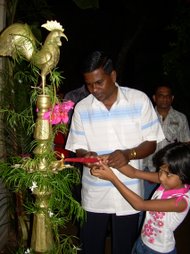Ancient Rituals in sri Lanka‘Gam Maduwa’
 Just as much as villagers flock to the temple whenever a ‘pirith’ ceremony is held, people gather in large numbers when other folk rituals are performed. A ‘gam maduwa’, an elaborate ritual based on age-old customs and traditions would draw the entire village for an all-night outing. So will a ‘bali’ ceremony or a ‘thovil’ attract villagers in their numbers. These are community gatherings where people participate voluntarily. A ‘gam maduwa’ being an elaborate ceremony is not held very often. Being a rare event, it attracts village-folk from the surrounding villages as well.
Just as much as villagers flock to the temple whenever a ‘pirith’ ceremony is held, people gather in large numbers when other folk rituals are performed. A ‘gam maduwa’, an elaborate ritual based on age-old customs and traditions would draw the entire village for an all-night outing. So will a ‘bali’ ceremony or a ‘thovil’ attract villagers in their numbers. These are community gatherings where people participate voluntarily. A ‘gam maduwa’ being an elaborate ceremony is not held very often. Being a rare event, it attracts village-folk from the surrounding villages as well.
As the name suggests, a ‘gam maduwa’ is a village affair. It is performed in a temporary shed erected for the occasion. It is of special interest to the farmers, for whom a ‘gam maduwa’ would bring in blessings of the gods for success in their agricultural activities. Others too believe that it would bring a lot of good to the village. It falls into the category of rituals known as ‘shanti  karma’ and is a ritual with mass participation.
karma’ and is a ritual with mass participation.
The Sri Lankan village is very much connected with agriculture. Thus folk rituals centre round customs, traditions, beliefs and other practices related to agriculture. The first portion of the harvest is offered to the gods and rice is used to offer alms thanking the gods and asking them for the protection of the next crop. Boiling of milk is also another way of hoping for a bountiful harvest.
The shed or hall built as the ‘maduwa’ is generally around 60 feet in length and 20 feet in width. It is gaily decorated with ‘gokkola’. A pandal adorns the entrance to the ‘maduwa’. Hung on it are different kinds of fruit. The erection of the hall begins at an auspicious time when a vow is made to the gods promising to have the ‘gam maduwa’ on a specific date.
The central figure in the ‘gam maduwa’ is goddess Pattini whose symbolic emblem is kept on a special dais in the centre. In front is the ‘mal asanaya’ where flowers are offered with paintings of the goddess on either side.
 Other deities who are worshipped in the region are also featured.
Other deities who are worshipped in the region are also featured.
During the nightlong ceremony verses invoking the blessings mentioning these gods are sung and numerous forms of traditional dances are performed to the accompaniment of drums.
The ‘pandam paliya’ or the torch dance is of significance where the torches keep burning throughout the night. ‘Bali’ is a less elaborate form of ritual than ‘gam maduwa’ and is basically a sacrifice to the deities. It is closely related with astrology and often a ‘bali’ ceremony is held when someone is having a bad time or is suffering from a serious illness. ‘The bali adura’ officiates using a whole heap of paraphernalia including ‘pol mal’ (coconut flowers), ‘puwak mal’ (arecanut flowers), stems of plantain trees, flowers of at least five different colours, betel, coconuts and lime. Although a ‘bali’ ceremony is held for an individual or a family, sometimes it is also planned to bless a whole village. Lots of chants are recited while offering many types of food to deities, spirits and demons. These are all done with the hope of getting some favours. It may be an appeal to cure an illness or to improve a business, which had collapsed.
The ‘bali’ ceremony begins in late evening in a specially decorated pavilion where images of deities and others are exhibited. If it is held to cure a sick person, he or she will sit or lie down in a corner. A cock is generally kept tied to an image. Dancing, chanting and drumming continue throughout the night and towards the end there is frantic dancing by the ‘bali adura’ or chief official who falls flat on the ground as the climax is reached. His assistant would quickly get near him with an ash pumpkin, which is kept on his chest and cut in two. The departure of the evil spirit is marked by the somewhat rash behaviour of the ‘adura’ who runs about pulling down the decorations and other stuff. The breaking up a branch signals the end of the whole episode. The ‘aturaya’ then leaves quite exhausted yet with the fervent hope that he would be cured.
Pics and text from Internet
---------http://www.lakbimanews.lk/education/edu2.htm





















































No comments:
Post a Comment